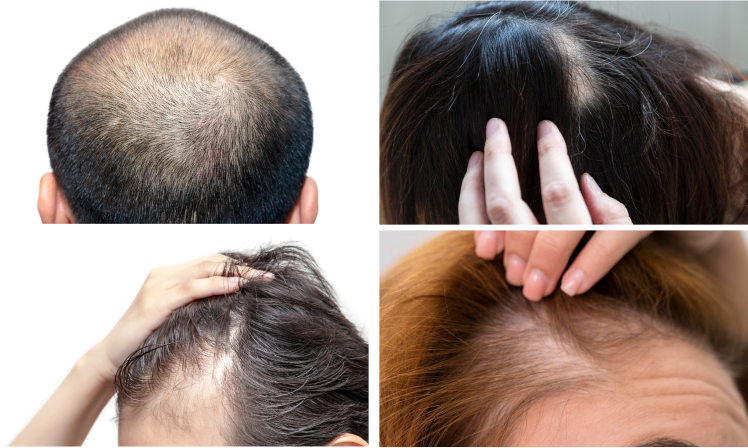
Types of hair fall

Distinguishing Hair Fall from Hair Loss
Hair fall, a daily shedding of up to 100 strands, can evolve into persistent hair loss over a month. Identifying this transition is key to understanding and addressing hair concerns effectively.

Hair Growth Phases
Hair growth unfolds through distinctive phases:
Anagen (2-8 Years)
The growth phase
Catagen (10 Days)
The transition phase
Telogen (About 3 Months)
The resting phase
Exogen
Shedding old hair and fostering new growth
Key reasons for Hair loss
1. Androgenic Alopecia (Male Pattern Baldness / Female Pattern Hair Loss)
Key signs:
- Family history (maternal and paternal)
- Prolonged hair loss (over 6 months)
- Recognizable patterns (receding hairline, thinning/balding crown for men; widening partition, increased scalp visibility for women)
- Reduced density or volume
- Absence of recent health issues (excluding comorbidities)

Can it happen at a young age?
In short – yes. And it has become more frequent today, leading to significant mental stress on young men and women.
Onset is often influenced by diet, lifestyle, and various triggers related to stress, hormones, poor sleep. Early onset (even at 18) due to lifestyle factors can exacerbate pattern hair loss. Late onset is typically age-related and takes place due to the aging process.Male and Female Pattern baldness can be treated with natural, effective topicals with strong hair growth ingredients (e.g. Bhringraj, Turmeric, Amla etc.) and lifestyle and diet changes to reinforce follicle strength and oxygen supply to the scalp.

2. Telogen Effluvium (TE)
Typically, a healthy scalp houses 80-90% of hair in the growth phase. TE, triggered by stress or shock, redirects 40% or more into the resting phase, resulting in sudden increased hair loss.
Spotting Triggers
- Surgical procedures
- Major physical trauma
- Intense psychological stress
- High fever or severe illness
- Dramatic weight loss or diet changes
- Hormonal fluctuations (associated with childbirth, menopause)
- Iron deficiency
- Thyroid imbalances
- Certain medications
Swift intervention is crucial, as TE is temporary but can lead to significant volume loss, necessitating targeted treatment for recovery.
3. Alopecia Areata
This autoimmune disorder prompts the immune system to attack follicles, causing coin-sized circular bald patches. Severe cases may involve hair loss in other body parts.
While Ayurveda can definitely help manage it, in case of late stages it does not have a clear solution. We recommend consulting a local dermatologist for a complete solution.




